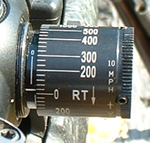Kenton Offers Custom-Calibrated Windage and Elevation Knobs
 Here’s something that can save you lots of time and aggravation on a varminting trip. This little $110 gizmo is great for varmint hunters and any one who needs to make a quick shot in shifty wind conditions. Instead of the traditional 1/4-MOA hash marks, the Kenton windage turret features markers corresponding to the wind drift your ammo will encounter at various distances (with 10 mph full value winds). You just dial the distance.
Here’s something that can save you lots of time and aggravation on a varminting trip. This little $110 gizmo is great for varmint hunters and any one who needs to make a quick shot in shifty wind conditions. Instead of the traditional 1/4-MOA hash marks, the Kenton windage turret features markers corresponding to the wind drift your ammo will encounter at various distances (with 10 mph full value winds). You just dial the distance.
Custom-Calibrated Windage Knobs
Kenton Industries’ Tuned Windage Compensator (TWC) has built-in windage marks for 10 mph cross-winds at 100-1000 yards. How do they do that? Well the knobs are calibrated either for specific calibers/loads, or they can make custom knobs using your observed field data. The knobs can compensate for various wind speeds (2-20 mph) and angles (15°- 90°), by applying some simple conversion ratios. As a general rule, with a “full-value”, i.e. 90°, crosswind, the wind drift will go up or down in direct proportion to the change in windspeed. That means, for example, a 10 mph crosswind will push the bullet twice as much sideways as a 5 mph crosswind.
Two versions of Kenton’s TWC knobs are offered. The $109.95 TWC #1 features calculated ballistics for standardized factory ammo for the caliber and barrel length you specify. The $109.95 TWC #2 feature customized windage settings based on bullet BC, environmental conditions, elevation, and ballistic information you provide.
Custom Elevation Knobs
Kenton also makes a $109.95 elevation-compensating TTC knob, that can be customized to your rifle. With this elevation turret, yardages are marked in 50-yard increments, and you can literally just “dial in your distance”. However, to work effectively the TTC knob must be tailored to a particular load (velocity and bullet). Moreover, actual bullet drop will differ with changes in altitude, temperature, and shooting angle — so it’s not as simple as it sounds, and you may need multiple knobs if you shoot a variety of loads. Kenton offers it TTC #1 model calibrated for standardized factory ammo. The TTC #2 is calibrated out to the maximum effective range of your cartridge based on bullet type, muzzle velocity, altitude, and temperature. Select the type of yardage format to be used. The #2 is recommended for wildcatters or for those who want to adjust to specific conditions. Lastly, a TTC #3 elevation knob is offered that relies on the purchaser’s actual recorded drop data from the field. The TTC #3 elevation knob will be calibrated based on the click-value or MOA you provide for each 50-yard increment.
Similar Posts:
- Custom-Calibrated Windage & Elevation Knobs from Kenton
- Tuned Windage Compensating Knob from Kenton
- Kenton Calibrated Windage Knob
- Zeiss Offers Free Calibrated Elevation Turret with Some Scopes
- Zeiss Extends Custom Ballistic Turret Offer Through End of 2013
Tags: ballistics, Elevation, Optics, Scope, Turret, Wind, Windage


















Normally I keep negative comments to myself, but this is too much.
IMO, this windage turret is a terribly inflexible approach to compensating for wind. You’re supposed to dial the range which corresponds to a 10 mph cross wind? What if the wind is 7 mph? What if it’s a 12 mph fishtail wind? I’m sure there’s some kind of system of rules to compensate for these scenarios, but I’m also sure it’s far more complex than shooters will be happy doing ‘on the fly’ in a changing wind field.
And for over $100! I sure hope too many shooters don’t get tricked into this.
-Bryan
Bryan,
I understand your concern. When I studied this I first wondered how the windage setting was set… what wind velocity and what wind direction. Well, it’s based on 10mph 90-degree full value. If you’ve got something different you’re supposed to pick a different setting.
Where I see this useful is at ranges where one has predictable morning to afternoon velocity changes. Out here on the Pacific coast we get a predicatable thermal sea breeze. Mornings are calm, and then the sea breeze (from the West) kicks in pretty reliably. Dialing the distance with a know quantity of wind might be useful. But then, if you know what the wind is likely to do, one could just keep a click chart, which as you say, is far less expensive than $100.00.